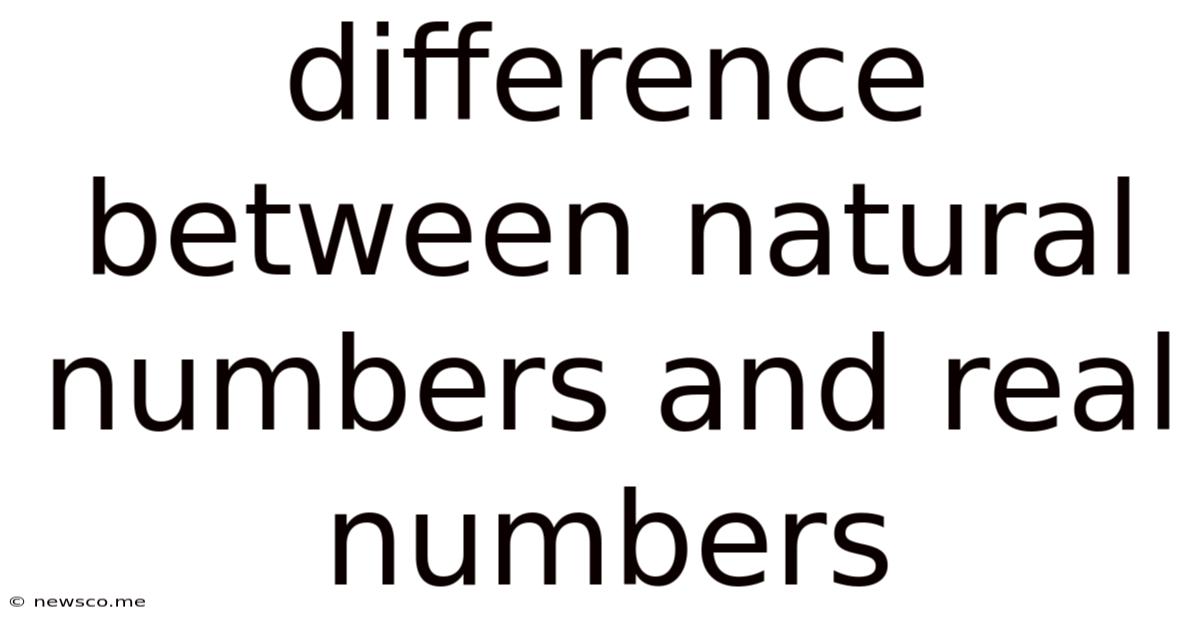Difference Between Natural Numbers And Real Numbers
News Co
Apr 28, 2025 · 5 min read

Table of Contents
Delving Deep: Unveiling the Differences Between Natural and Real Numbers
Mathematics, a cornerstone of scientific understanding, relies on a robust system of numbers. Among the vast landscape of numerical systems, natural numbers and real numbers stand out as fundamental yet distinct concepts. While both play crucial roles in various mathematical applications, understanding their differences is key to mastering mathematical principles. This comprehensive guide will explore the nuances of natural and real numbers, clarifying their definitions, properties, and applications.
Defining Natural Numbers: The Foundation of Counting
Natural numbers, often denoted by ℕ, represent the most intuitive concept of numbers – the counting numbers. They begin with 1 and extend infinitely, forming a sequence: 1, 2, 3, 4, 5, ... These numbers are used for basic counting and enumeration, making them the cornerstone of arithmetic.
Key Properties of Natural Numbers:
- Positive Integers: Natural numbers are all positive integers. They exclude zero and negative numbers.
- Discrete Nature: Natural numbers are discrete; there's a clear gap between each consecutive number. There's no natural number between 2 and 3, for example.
- Countable Infinity: While infinite, the set of natural numbers is countable. This means you could theoretically assign each natural number to a unique element in a list, even though the list continues infinitely.
- Closed Under Addition and Multiplication: Adding or multiplying any two natural numbers always results in another natural number. This property is known as closure.
Exploring Real Numbers: A Broader Perspective
Real numbers, denoted by ℝ, encompass a much broader range of numbers than natural numbers. They include all rational and irrational numbers, forming a continuous number line.
Rational Numbers: Fractions and Decimals
Rational numbers are numbers that can be expressed as a fraction p/q, where 'p' and 'q' are integers, and 'q' is not zero. This includes all integers (which can be expressed as p/1) and many decimal numbers that either terminate (like 0.75) or repeat (like 0.333...).
Irrational Numbers: The Unrepeating, Non-terminating Decimals
Irrational numbers are numbers that cannot be expressed as a fraction of two integers. Their decimal representations are infinite and non-repeating. Famous examples include π (pi) and √2 (the square root of 2). These numbers add a significant layer of complexity to the real number system.
Key Properties of Real Numbers:
- Continuity: The real number line is continuous; between any two real numbers, you can always find another real number. This contrasts sharply with the discrete nature of natural numbers.
- Uncountable Infinity: The set of real numbers is uncountable. You cannot assign each real number to a unique position in a list, demonstrating a higher level of infinity than natural numbers.
- Density: Real numbers are dense; between any two distinct real numbers, there are infinitely many other real numbers.
- Order: Real numbers are ordered; given any two real numbers, one is always greater than, less than, or equal to the other. This allows for comparisons and ordering along the number line.
- Completeness: The real number system is complete, meaning it contains all its limit points. This property ensures that sequences of real numbers that converge to a limit always have that limit within the real numbers. This property is crucial in calculus and analysis.
Key Differences Summarized: A Side-by-Side Comparison
The following table summarizes the key differences between natural and real numbers:
| Feature | Natural Numbers (ℕ) | Real Numbers (ℝ) |
|---|---|---|
| Definition | Positive integers (1, 2, 3, ...) | All rational and irrational numbers |
| Zero | Excluded | Included (0) |
| Negative Numbers | Excluded | Included (-1, -2, -3, ...) |
| Fractions | Excluded (except for integers considered as p/1) | Included (e.g., 1/2, 3/4) |
| Decimals | Excluded (except for terminating decimals representing integers) | Included (terminating, repeating, and non-repeating) |
| Type of Infinity | Countable | Uncountable |
| Nature | Discrete | Continuous |
Applications and Significance: Where Each Number System Shines
The choice between using natural numbers or real numbers depends entirely on the context.
Natural Numbers in Action:
- Counting and Enumeration: Counting objects, steps, or events.
- Discrete Mathematics: Graph theory, combinatorics, and other areas where discrete structures are essential.
- Computer Science: Indexing data structures, iteration in programming loops.
- Basic Arithmetic: Simple addition, subtraction, multiplication, and division of whole numbers.
Real Numbers in Action:
- Measurement: Representing continuous quantities like length, weight, and temperature.
- Calculus and Analysis: Essential for studying limits, derivatives, integrals, and other advanced mathematical concepts.
- Geometry: Describing lengths, areas, and volumes of shapes.
- Physics and Engineering: Modeling continuous phenomena, solving differential equations.
- Finance: Handling interest rates, stock prices, and other continuous financial variables.
Beyond the Basics: Further Explorations
The distinction between natural and real numbers forms the foundation for exploring more advanced number systems like complex numbers (which involve the imaginary unit i), and the fascinating world of set theory, which provides a formal framework for understanding the properties and relationships between different sets of numbers.
Understanding the differences between natural and real numbers is not just an academic exercise; it is crucial for comprehending the mathematical underpinnings of countless applications across various disciplines. From basic counting to advanced calculus and beyond, the properties and characteristics of these number systems provide the tools needed to quantify, model, and interpret the world around us. As you continue to delve deeper into the realm of mathematics, remembering these fundamental differences will serve as a solid foundation for future learning.
Latest Posts
Related Post
Thank you for visiting our website which covers about Difference Between Natural Numbers And Real Numbers . We hope the information provided has been useful to you. Feel free to contact us if you have any questions or need further assistance. See you next time and don't miss to bookmark.